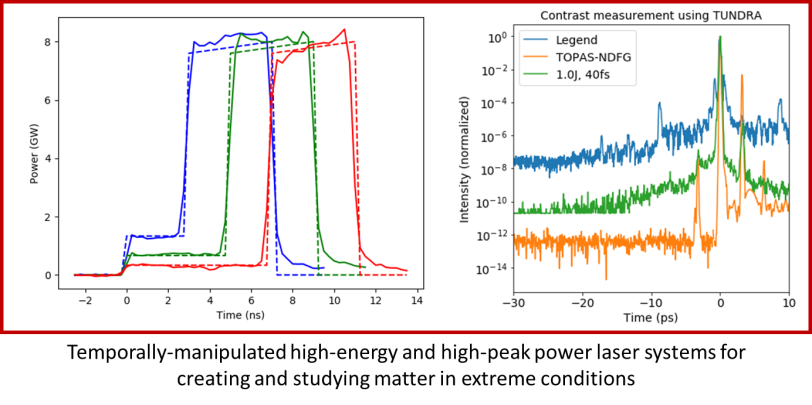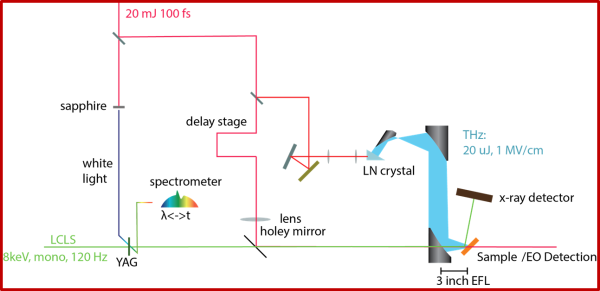Laser Research & Development
Advanced Laser Sources
Research efforts and facility upgrades are driving continued improvement in high energy laser systems. This includes high power OPCPA/OPA and direct compression of fs and ps laser sources. Support is also directed to further development of the laser injector system for the FEL. Higher power laser systems has close coordinate with Matter in Extreme Conditions.
See MEC-U and OPCPA development for information on a couple of specific projects.
The Advanced Laser Sources group leads the scientific development of drive laser sources across LCLS. This includes support of the operation of these sources, exploration of new approaches and techniques for drive laser sources, and coordination with the MEC department to support high-energy and high-intensity laser capabilities. The group maintains a strong connection with the Laser Engineering department, who support the day-to-day operation and maintenance of systems in addition to supporting projects to implement new developments.
The following are highlights of the scope covered by the Advanced Laser Sources group:
- high-power laser systems including OPCPA and pulse compression of 1um laser sources
- conventional Ti:Sapphire systems and the MEC glass laser system
- future MEC-U Petawatt and kJ laser systems
- accelerator laser systems and XFEL laser science

Mid-infrared and Terahertz Sources
The THz frequency range spans the gap between microwaves and the infrared part of the electromagnetic spectrum. At LCLS we use laser-based methods to generat strong THz and mid-IR sources to control properties of complex materials on a sub-picosecond time scale. One area of focus is the development of a tabletop THz source using difference frequency generation, optical rectification and various other techniques. Techniques for the application of these THz and mid-IR sources in experiments are ongoing.
Coordination with the MAT Dept helps drive the research interests for mid-IR and THz sources and applications.
The Infrared and Terahertz Sources group leads the development of strong-field THz and far-infrared laser sources. This includes integration and support of these sources in LCLS and UED user experiments and coordination with other Materials Science department and in-house science program on manipulation of matter with THz fields.
The following are highlights of the scope covered by the Ultrafast UV-Vis Sources group:
- THz and IR sources for LCLS science
- in-house science program using new sources to enable early science at LCLS-II
- ASC THz lab as space for collaborative efforts, available to both internal and external users

Laser Metrology and Novel Methodologies
Current research focuses on developing and refining various techniques for temporal, spectral, spatial, etc. pulse characterization. Research is also focused on methods for temporal and spatial overlap of laser pulses with x-rays. Incorporating long-pulse laser sources, such as YAGs and OPOs, are undergoing development.
Coordination on science needs with the Bio Dept. is ongoing to further refine research interests.
The Ultrafast Metrology & Methods group leads the development of techniques to characterize key optical laser and laser timing performance parameters. This includes driving developments to improve integration of laser sources and measurement techniques in LCLS beamlines and ensuring these are consistent with the science mission. This also includes support of mobile laser systems, such as the nanosecond lasers typically used in Bio experiments.
The following are highlights of the scope covered by the Ultrafast UV-Vis Sources group:
- deployment of engineered laser sources at LCLS
- scientific timing developments for LCLS experiments
- laser characterisation and control
Ultrafast Visible and Ultraviolet Pulses
This work focuses on the generation of ultrafast (few cycle) pulses in the ultraviolet and visible regions using nonlinear processes. These processes include harmonic generation (HG), optical parametric amplification (OPA), four-wave mixing, resonant dispersive wave emission, etc.
This research is in close coordination with the AMO Dept. and Chem Dept.
The Ultrafast UV-Vis Sources group leads the development of ultrafast secondary sources in the UV-visible spectral range. This includes support of the implementation of these sources in experiments and coordination with other science departments, AMOS and Chemical Sciences in particular, to understand and respond to future needs, with a goal of fully exploiting UV and visible laser sources in LCLS experiments.
The following are highlights of the scope covered by the Ultrafast UV-Vis Sources group:
- conventional crystal based harmonic generation, OPA + mixing techniques
- spectral broadening & pulse compression
- novel approaches to UV-vis generation for high average power application













